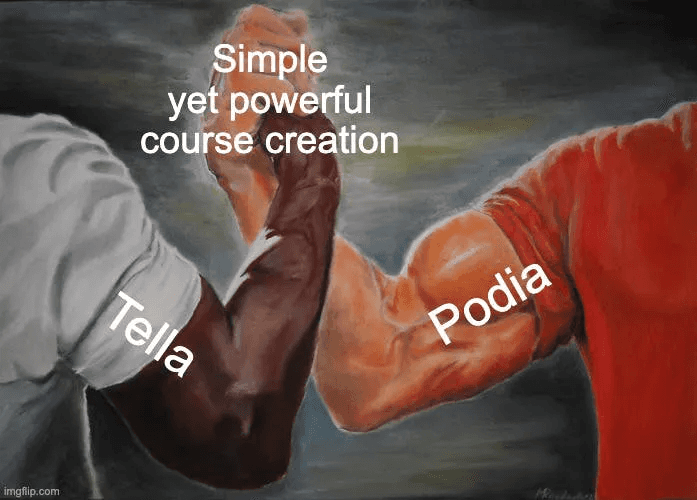June 16, 2023
How to Create and Sell a Course with Tella & Podia

Grant
Course creation is all the rage these days. It's never been easier to turn your passion into a money-making machine.
People make courses for all sorts of things, like learning how to code in weird programming languages, running ads on Facebook, getting good at Minecraft, becoming a better UI designer, or writing a novel. You probably know something well enough to teach someone else, and creating a course about it might be your ticket to financial freedom... or just a way to contribute to the world's knowledge.
Today's tools mean you can record and launch a course in half a day, so experimenting is really easy. This also means you can test the demand for your course a lot better and iterate on ideas faster. If you're considering becoming a full-time course creator, then the impact of it not working out is low. If you want to create courses as a side hustle, then it's a manageable amount of work to fit into the rest of your life.

The goal of this iNtErAcTiVe blog post (text and videos, to keep you stimulated) is to help you get started with course creation, fast. Like many things in life, you never know if something is right for you until you try it. So the faster you can try something, the better. By the end of this post you'll know how to:
Plan and prepare your first lesson
Record and edit it
Publish it on your own course website
The post focusses on two apps: Tella and Podia. Together they cover most of the process. Tella will help you record an awesome looking set of videos with very little editing needed. And Podia will take care of the rest.

All you need for this entire process is your trusty web browser: it's online course creation, online.
As an example, I'll explain how to record and publish the first lesson in a fictional course I'm creating: The Beginner's Guide to Figma.
Let's get into it.
Step 1: Planning your first lesson
No one loves planning. But when you're recording a course, planning goes a long way.
Working out what your course will cover and what's in each lesson makes recording easier. It will also help you stay concise and on topic. The result of a well planned lesson is a better viewing experience for your students.
In this video I'll show you:
How to write a basic lesson script
How to plan the different types of recordings you'll need
How to start planning other content, like slides
Step 2: Preparing your slides
Slides give your lesson structure and make it more visually appealing (pretty).
Course creation has become extremely popular, so it's important that your course stands out and reflects your style. Tella has a bunch of different ways for you to customise your video's appearance, but spending some time creating intro slides will give it extra personality.
Keep it simple by creating slides using Google Slides, Keynote, PowerPoint, or Pitch. Or get more creative by using tools like Figma and Canva.
In this video I'll explain:
Why adding slides is important
What tools to use
An overview of the slides I made for the example lesson
How to add slides in Tella
Step 3: Recording your lesson
This is where the rubber hits the road. It's time to put that plan into action, add those slides, and start recording.
When using Tella the most important thing to remember is: think in clips. Map the topics in your plan to the clips you record in Tella. That way you can split your recording into short, manageable tasks. If you make mistakes or want to redo something, then it's only one clip that needs to be fixed.
In this video you'll learn:
How to record intro clips (using slide recordings)
How to record demo clips (using screen & camera recordings)
How to customise a video's appearance
How to get your video ready for publishing on Podia
Step 4: Creating & publishing your course website
Podia is an all-in-one platform for selling digital products. It's especially handy for selling courses. You can create simple course websites, customise availability, and collect payments. Podia also has a tonne of helpful guides and tutorials so that you can get the most out of the platform.
In this video you'll learn:
How to create your first product in Podia (hint: it's an online course).
How to add Tella videos as links for each lesson in your course (this avoids a bunch of downloading and re-uploading).
How to create and customise your own course website.
You're a course creator, Harry
Let's recap:
Plan your course content. This means the course itself, and the lessons. Prep scripts and the shots you want to capture.
Prepare your extra content. Slides are a simple way to make your video look great. There are tools galore for making great slides, so go nuts. Custom backgrounds are an extra bonus, but you can always make those later.
Record! Stick to your plan and follow your script. Split your lessons into one or two clips per topic — this makes recording and editing much easier.
Publish your videos. If you haven't got your course site prepared already, do that first. When you're up and running on Podia, just copy the link to your Tella video and add it to a "Text" section in the course editor.
There's loads more to discover in both Tella and Podia. But the four steps covered in this post should get you started. Before long you'll be a legit course creator.
Happy course creating!



